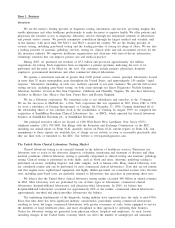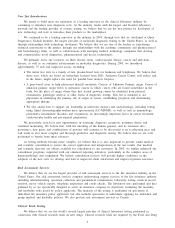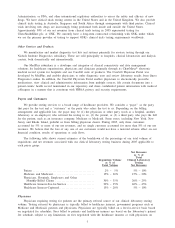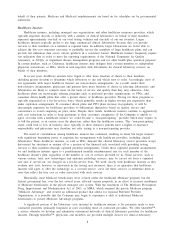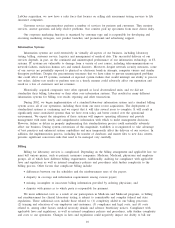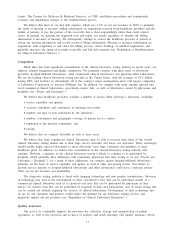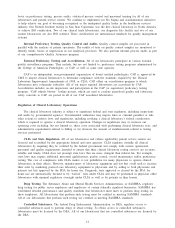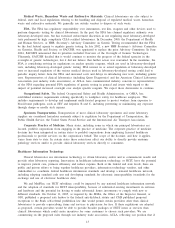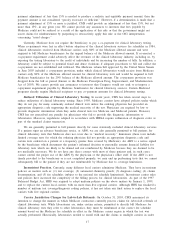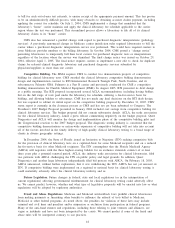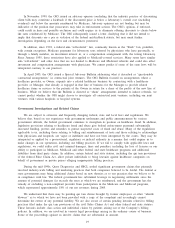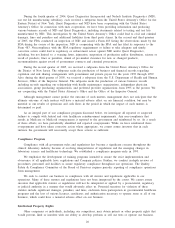Quest Diagnostics 2005 Annual Report Download - page 27
Download and view the complete annual report
Please find page 27 of the 2005 Quest Diagnostics annual report below. You can navigate through the pages in the report by either clicking on the pages listed below, or by using the keyword search tool below to find specific information within the annual report.LabOne acquisition, we now have a sales force that focuses on selling risk assessment testing services to life
insurance companies.
Customer service representatives perform a number of services for patients and customers. They monitor
services, answer questions and help resolve problems. Our couriers pick up specimens from most clients daily.
Our corporate marketing function is organized by customer type and is responsible for developing and
executing marketing strategies, new product launches, and promotional and advertising support.
Information Systems
Information systems are used extensively in virtually all aspects of our business, including laboratory
testing, billing, customer service, logistics and management of medical data. The successful delivery of our
services depends, in part, on the continued and uninterrupted performance of our information technology, or IT,
systems. IT systems are vulnerable to damage from a variety of root causes, including telecommunications or
network failures, malicious human acts and natural disasters. Moreover, despite network security measures, some
of our servers are potentially exposed to physical or electronic break-in attempts, computer viruses and similar
disruptive problems. Despite the precautionary measures that we have taken to prevent unanticipated problems
that could affect our IT systems, sustained or repeated system failures that would interrupt our ability to process
test orders, deliver test results or perform tests in a timely manner could adversely affect our reputation and
result in a loss of customers and net revenues.
Historically, acquired companies were often operated as local decentralized units, and we did not
standardize their billing, laboratory or their other core information systems. This resulted in many different
information systems for billing, test results reporting and other transactions.
During 2002, we began implementation of a standard laboratory information system and a standard billing
system across all of our operations, including those from our most recent acquisitions. The deployment of
standardized systems is continuing and we expect that it will take several years to complete. It will result in
significantly more centralized systems than we have even today and better control over the operational
environment. We expect the integration of these systems will improve operating efficiency and provide
management with more timely and comprehensive information with which to make management decisions.
However, failure or delays in properly implementing this standardization process could materially adversely
affect our business. During system conversions of this magnitude, workflow is re-engineered to take advantage
of best practices and enhanced system capabilities and may temporarily affect the delivery of our services. In
addition, the implementation process, including the transfer of databases and master files to new data centers,
presents significant conversion risks that need to be managed very carefully.
Billing
Billing for laboratory services is complicated. Depending on the billing arrangement and applicable law, we
must bill various payers, such as patients, insurance companies, Medicare, Medicaid, physicians and employer
groups, all of which have different billing requirements. Additionally, auditing for compliance with applicable
laws and regulations as well as internal compliance policies and procedures adds further complexity to the
billing process. Other factors that complicate billing include:
•differences between our fee schedules and the reimbursement rates of the payers;
•disparity in coverage and information requirements among various payers;
•missing, incomplete or inaccurate billing information provided by ordering physicians; and
•disputes with payers as to which party is responsible for payment.
We incur additional costs as a result of our participation in Medicare and Medicaid programs, as billing
and reimbursement for clinical laboratory testing is subject to considerable and complex federal and state
regulations. These additional costs include those related to: (1) complexity added to our billing processes;
(2) training and education of our employees and customers; (3) compliance and legal costs; and (4) costs
related to, among other factors, medical necessity denials and advance beneficiary notices. Compliance with
applicable laws and regulations, as well as internal compliance policies and procedures, adds further complexity
and costs to our operations. Changes in laws and regulations could negatively impact our ability to bill our
10



